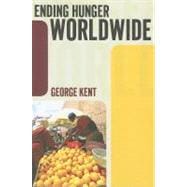
Note: Supplemental materials are not guaranteed with Rental or Used book purchases.
Purchase Benefits
What is included with this book?
| Preface | p. ix |
| Nutrition Problems | p. 1 |
| Numbers and Definitions | p. 1 |
| Food Security versus Nutrition Security | p. 4 |
| Other Perspectives | p. 7 |
| Achieve Sustainability or End Hunger? | p. 9 |
| Indifference? | p. 13 |
| Conflicting Interests | p. 16 |
| Invest in Ending Hunger? | p. 20 |
| The Copenhagen Confusion | p. 22 |
| Hunger as Structural Violence | p. 23 |
| The Moral Dimension-Compassion | p. 24 |
| Transcending Hunger | p. 26 |
| Widening Gaps | p. 28 |
| Evidence of Widening Gaps | p. 28 |
| Explanation | p. 32 |
| The Globalization of Widening Gaps | p. 37 |
| Self-Reliant Communities | p. 38 |
| Food Trade | p. 41 |
| Concentration of Wealth and Power | p. 41 |
| Subsidies | p. 44 |
| Foreign Interests | p. 46 |
| Grabbing Land and Sea | p. 48 |
| Free Trade Agreements | p. 56 |
| Non-Market Values | p. 58 |
| Food Trade | p. 60 |
| Remedies | p. 62 |
| Rights-Based Social Systems | p. 65 |
| The Essence of Rights Systems | p. 65 |
| Varieties of Rights | p. 66 |
| Rights-Based Programs in Schools | p. 67 |
| Human Rights Principles | p. 70 |
| The Human Right to Adequate Food | p. 74 |
| Entitlements | p. 74 |
| The Human Right to an Adequate Standard of Living | p. 75 |
| Global Recognition of the Right to Food | p. 76 |
| UN General Comment 12 | p. 79 |
| Voluntary Guidelines | p. 81 |
| Dignity | p. 83 |
| Global Obligations | p. 86 |
| The Global Food System | p. 86 |
| Global Obligations | p. 87 |
| The Right to Food Viewed Globally | p. 89 |
| Levels of Global Obligation | p. 90 |
| The Need for Planning | p. 92 |
| Nutritional Safety Nets | p. 94 |
| Defining Nutritional Safety Nets | p. 94 |
| Guaranteed Safety Nets | p. 97 |
| Designing Guaranteed Nutritional Safety Nets | p. 99 |
| Global Nutritional Safety Nets | p. 103 |
| Cautions | p. 105 |
| The Role of International Law | p. 107 |
| Key Features of Safety Net Programs | p. 109 |
| Household Food Production | p. 110 |
| Methods of Household Food Production | p. 111 |
| Beyond Primary Production | p. 113 |
| Cautions | p. 114 |
| Networking | p. 117 |
| Community-Based Food Production | p. 118 |
| The Role of Government | p. 119 |
| Political Significance | p. 120 |
| Community-Based Nutrition Security | p. 122 |
| Localization and Its Limits | p. 122 |
| Priority on Self-Reliance, Not Self-Sufficiency | p. 124 |
| Food Sovereignty | p. 130 |
| Democracy Is Not Enough | p. 133 |
| The Need for Community | p. 134 |
| Food/Nutrition Policy Councils | p. 142 |
| A Forum on Nutrition Issues | p. 142 |
| Task Forces | p. 144 |
| Describing Food Systems | p. 147 |
| Assessing Food Systems | p. 148 |
| Improving Food Systems | p. 149 |
| Nutrition Policy Councils and Rights | p. 151 |
| The Mission of Nutrition Policy Councils | p. 152 |
| Diagnosing Global Approaches | p. 154 |
| The Global Efforts | p. 154 |
| The Millennium Promise | p. 158 |
| The Medical Approach to Malnutrition | p. 159 |
| Coordination Without Planning | p. 164 |
| Modest Aspirations | p. 167 |
| Multi-Level Strategic Planning | p. 170 |
| Inclusive Global Planning | p. 172 |
| Global Support for Local Self-Reliance | p. 174 |
| Subsidiarity | p. 177 |
| The Cellular Approach | p. 178 |
| Layered Nutrition Policy Councils | p. 180 |
| Building the Motivation to End Hunger | p. 182 |
| Appendix: American Samoa Executive Order | p. 185 |
| Bibliography | p. 191 |
| Index | p. 217 |
| About the Author | p. 225 |
| Table of Contents provided by Ingram. All Rights Reserved. |
The New copy of this book will include any supplemental materials advertised. Please check the title of the book to determine if it should include any access cards, study guides, lab manuals, CDs, etc.
The Used, Rental and eBook copies of this book are not guaranteed to include any supplemental materials. Typically, only the book itself is included. This is true even if the title states it includes any access cards, study guides, lab manuals, CDs, etc.